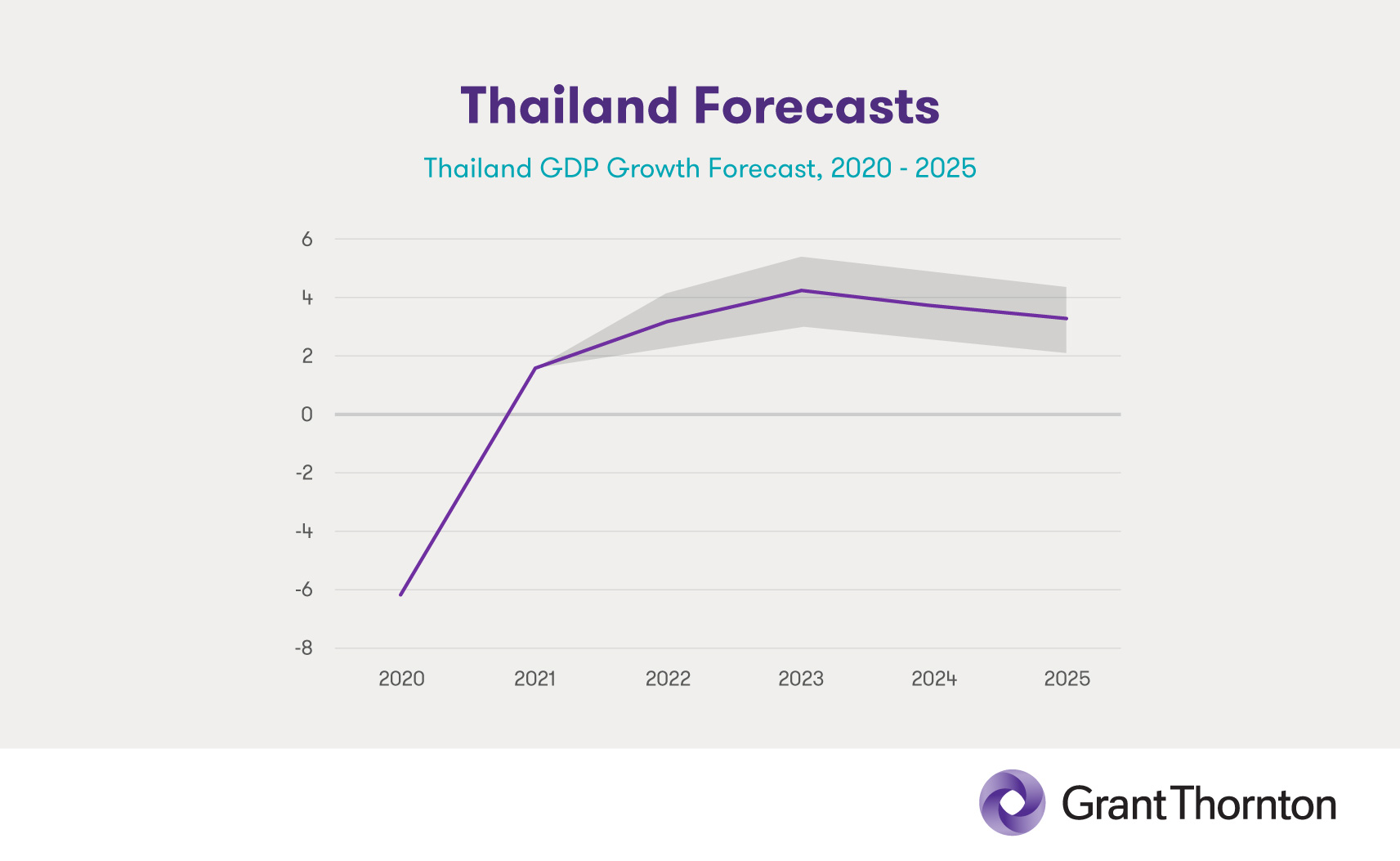-
Internal audit
In today's increasingly competitive and regulated market place, organisations - both public and private - must demonstrate that they have adequate controls and safeguards in place. The availability of qualified internal audit resources is a common challenge for many organisations.
-
IFRS
At Grant Thornton, our International Financial Reporting Standards (IFRS) advisers can help you navigate the complexity of financial reporting so you can focus your time and effort on running your business.
-
Audit quality monitoring
Having a robust process of quality control is one of the most effective ways to guarantee we deliver high-quality services to our clients.
-
Global audit technology
We apply our global audit methodology through an integrated set of software tools known as the Voyager suite.
-
Looking for permanent staff
Grant Thornton's executive recruitment is the real executive search and headhunting firms in Thailand.
-
Looking for interim executives
Interim executives are fixed-term-contract employees. Grant Thornton's specialist Executive Recruitment team can help you meet your interim executive needs
-
Looking for permanent or interim job
You may be in another job already but are willing to consider a career move should the right position at the right company become available. Or you may not be working at the moment and would like to hear from us when a relevant job comes up.
-
Practice areas
We provide retained recruitment services to multinational, Thai and Japanese organisations that are looking to fill management positions and senior level roles in Thailand.
-
Submit your resume
Executive recruitment portal
-
Update your resume
Executive recruitment portal
-
Available positions
Available positions for executive recruitment portal
-
General intelligence assessments
The Applied Reasoning Test (ART) is a general intelligence assessment that enables you to assess the level of verbal, numerical reasoning and problem solving capabilities of job candidates in a reliable and job-related manner.
-
Candidate background checks
We provide background checks and employee screening services to help our clients keep their organisation safe and profitable by protecting against the numerous pitfalls caused by unqualified, unethical, dangerous or criminal employees.

-
Capital markets
If you’re buying or selling financial securities, you want corporate finance specialists experienced in international capital markets on your side.
-
Corporate simplification
Corporate simplification
-
Expert witness
Expert witness
-
Family office services
Family office services
-
Financial models
Financial models
-
Forensic Advisory
Investigations
-
Independent business review
Does your company need a health check? Grant Thornton’s expert team can help you get to the heart of your issues to drive sustainable growth.
-
Mergers & acquisitions
Mergers & acquisitions
-
Operational advisory
Grant Thornton’s operational advisory specialists can help you realise your full potential for growth.
-
Raising finance
Raising finance
-
Restructuring & Reorganisation
Grant Thornton can help with financial restructuring and turnaround projects, including managing stakeholders and developing platforms for growth.
-
Risk management
Risk management
-
Technology & Digital Services
Technology Services
-
Transaction advisory
Transaction advisory
-
Valuations
Valuations
-
Human Capital Consulting
From time to time, companies find themselves looking for temporary accounting resources. Often this is because of staff leaving, pressures at month-end and quarter-end, or specific short-term projects the company is undertaking.
-
Strategy & Business Model
Strategy & Business Model
-
Process Optimisation & Finance Transformation
Process Optimisation & Finance Transformation
-
System & Technology
System & Technology
-
Digital Transformation
Digital Transformation
-
International tax
With experts working in more than 130 countries, Grant Thornton can help you navigate complex tax laws across multiple jurisdictions.
-
Licensing and incentives application services
Licensing and incentives application services
-
Transfer pricing
If your company operates in more than one country, transfer pricing affects you. Grant Thornton’s experts can help you manage this complex and critical area.
-
Global mobility services
Employing foreign people in Australia, or sending Australian people offshore, both add complexity to your tax obligations and benefits – and we can guide you through them.
-
Tax compliance and tax due diligence review services
Tax compliance
-
Value-Added Tax
Value-Added Tax
-
Customs and Trade
Customs and Trade
-
Service Line
グラントソントン・タイランド サービスライン
-
Business Process Outsourcing
Companies, large and small, need to focus on core activities. Still, non-core activities are important, and they need to be leaner and more efficient than most companies can make them sustainably. For Grant Thornton, your non-core activities are our core business. Grant Thornton’s experienced outsourcing team helps companies ensure resilience, improve performance, manage costs, and enhance agility in resourcing and skills. Who better to do this than an organisation with 73,000 accountants? At Grant Thornton we recognise that that outsourcing your F&A functions is a strategic decision and an extension of your brand. This means we take your business as seriously as we take our own.
-
Technology and Robotics
We provide practical digital transformation solutions anchored in business issues and opportunities. Our approach is not from technology but from business. We are particularly adept at assessing and implementing fast and iterative digital interventions which can drive high value in low complex environments. Using digital solutions, we help clients create new business value, drive efficiencies in existing processes and prepare for strategic events like mergers. We implement solutions to refresh value and create sustainable change. Our solutions help clients drive better and more insightful decisions through analytics, automate processes and make the most of artificial intelligence and machine learning. Wherever possible we will leverage your existing technologies as our interest is in solving your business problems – not in selling you more software and hardware.
-
Technical Accounting Solutions
The finance function is an essential part of the organisation and chief financial officer (CFO) being the leader has the responsibility to ensure financial discipline, compliance, and internal controls. As the finance function is critical in every phase of a company’s growth, the CFO role also demands attention in defining business strategy, mitigating risks, and mentoring the leadership. We offer technical accounting services to finance leaders to help them navigate complex financial and regulatory environments, such as financial reporting and accounting standards, managing compliance requirements, and event-based accounting such as dissolutions, mergers and acquisitions.
-
Accounting Services
Whether you are a local Thai company or a multinational company with a branch or head office in Thailand you are obliged to keep accounts and arrange for a qualified bookkeeper to keep and prepare accounts in accordance with accounting standards. This can be time consuming and even a little dauting making sure you conform with all the regulatory requirements in Thailand and using Thai language. We offer you complete peace of mind by looking after all your statutory accounting requirements. You will have a single point of contact to work with in our team who will be responsible for your accounts – no matter small or large. We also have one of the largest teams of Xero Certified Advisors in Thailand ensuring your accounts are maintained in a cloud-based system that you have access to too.
-
Staff Augmentation
We offer Staff Augmentation services where our staff, under the direction and supervision of the company’s officers, perform accounting and accounting-related work.
-
Payroll Services
More and more companies are beginning to realize the benefits of outsourcing their noncore activities, and the first to be outsourced is usually the payroll function. Payroll is easy to carve out from the rest of the business since it is usually independent of the other activities or functions within the Accounting Department. At Grant Thornton employees can gain access to their salary information and statutory filings through a specialised App on their phone. This cuts down dramatically on requests to HR for information by the employees and increases employee satisfaction. We also have an optional leave approval app too if required.
-
 IBR Optimism of Thailand Mid-Market Leaders Suggests Potential Underestimation of Challenges Ahead: International Business Report, Q1 2024Bangkok, Thailand, April 2024 — The Grant Thornton International Business Report (IBR) for Q1 2024 unveils a strikingly optimistic outlook among Thailand's mid-market business leaders, juxtaposed with the looming challenges that will shape the nation's economic future. With a Business Health Index score of 13.5, Thailand outperforms its ASEAN, Asia-Pacific, and global counterparts, signaling a robust confidence that may overshadow critical issues such as demographic changes, skills shortages, and the necessity for digital advancement.
IBR Optimism of Thailand Mid-Market Leaders Suggests Potential Underestimation of Challenges Ahead: International Business Report, Q1 2024Bangkok, Thailand, April 2024 — The Grant Thornton International Business Report (IBR) for Q1 2024 unveils a strikingly optimistic outlook among Thailand's mid-market business leaders, juxtaposed with the looming challenges that will shape the nation's economic future. With a Business Health Index score of 13.5, Thailand outperforms its ASEAN, Asia-Pacific, and global counterparts, signaling a robust confidence that may overshadow critical issues such as demographic changes, skills shortages, and the necessity for digital advancement. -
 Workshop Corporate Strategy and Company Health Check WorkshopThroughout this workshop, we will delve into the life cycle of companies, examining the stages of growth, maturity, and adaptation. Our focus will extend to the current business environment, where your Company stands today, and how our evolving strategy aligns with the ever-changing market dynamics.
Workshop Corporate Strategy and Company Health Check WorkshopThroughout this workshop, we will delve into the life cycle of companies, examining the stages of growth, maturity, and adaptation. Our focus will extend to the current business environment, where your Company stands today, and how our evolving strategy aligns with the ever-changing market dynamics. -
 Tax and Legal update 1/2024 Introducing the New “Easy E-Receipt” Tax scheme with up to THB 50,000 in Tax DeductionsThe Revenue Department has introduced the latest tax scheme, the “Easy E-Receipt”, formerly known as “Shop Dee Mee Kuen”. This scheme is designed to offer individuals tax deductions in 2024.
Tax and Legal update 1/2024 Introducing the New “Easy E-Receipt” Tax scheme with up to THB 50,000 in Tax DeductionsThe Revenue Department has introduced the latest tax scheme, the “Easy E-Receipt”, formerly known as “Shop Dee Mee Kuen”. This scheme is designed to offer individuals tax deductions in 2024. -
 TAX AND LEGAL Complying with the PDPA – A Balancing ActOrganisations must be aware of the circumstances in which they are allowed to collect data to comply with Thailand’s Personal Data Protection Act.
TAX AND LEGAL Complying with the PDPA – A Balancing ActOrganisations must be aware of the circumstances in which they are allowed to collect data to comply with Thailand’s Personal Data Protection Act.
At last – most offices have reopened, COVID travel restrictions are behind us, and an influx of tourists is helping to shake Thailand’s economy back to life. Yet the road to recovery is by no means free of obstacles. With trade tensions, rising energy costs, and the spectre of inflation hanging over the Thai and global business world, companies should make every effort to understand and prepare for the new environment we are currently entering.
To help businesses navigate through challenging macroeconomic conditions, we are providing a brief analysis of Thailand’s GDP, inflation, and interest rate forecasts from 2020 to 2025. Regional and global statistics will also be used for comparative purposes.
A note before proceeding: The future is always uncertain, and the only guarantee is that there will be surprises along the way. This article simply aims to extrapolate from current trajectories and provide corresponding guidance for businesses; the scenarios outlined here should not be taken as absolute and firm projections.
Growth
Thailand’s GDP Forecast

Thailand’s real GDP for 2022 is forecasted to grow by 3.1% – nearly double the rate observed over the first quarter of the year. This increase reflects strong economic fundamentals, paired with a rise in tourist numbers as the remaining travel restrictions are lifted. Moreover, as manufacturing continues to rebound, we expect the country’s overall GDP growth to reach 4% in 2023.
However, 2024 should bring a moderate weakening of this growth trend, settling into a roughly 3% annual rate from 2024 through 2025. The reasons are outlined below, and include the types of inflationary challenges that other countries will also have to contend with.
These numbers take into account Thailand’s emerging cannabis market and the proposed casino legislation, both of which could contribute meaningfully to the Thai economy moving forward. Each of these sectors represents a promising area of business development, and will be worth watching as Thailand’s post-COVID business environment begins to take shape.
ASEAN GDP Growth Forecast

GDP growth across ASEAN is likely to outperform the more mature Thai economy in the years ahead. Our forecasts include a continued regional recovery into 2023, peaking at around 6% before levelling out at 5% until 2025. The curve of this ASEAN graph resembles Thailand’s own likely GDP arc – and for similar reasons, as inflation threatens to reduce purchasing power across borders.
Noteworthy here is the region’s ability to continue growing in 2022 despite ongoing disruptions caused by the Russia/Ukraine conflict as well as China’s economic slowdown. Findings from our recent International Business Report (IBR) help to illuminate the source of ASEAN’s economic resilience, as relatively few mid-market companies identify finance shortages or the availability of skilled labour as constraints to their business health.
The same report, however, shows that 51% of the mid-market businesses in the region are concerned about rising energy costs – a variable to watch closely while assembling a plan of operations for the coming months and years.
Global GDP Growth Forecast

Based on our own international research as well as external sources, we expect global growth forecasts to hold steady after 2022, remaining at around 3.5% until 2025. Our IBR survey respondents indicated muted economic optimism, profitability, and private investments for the current 12-month period, setting the tone for the medium term. Moreover, we expect that global inflation will peak in 2022 or early 2023 before beginning to ease down over the coming years.
Variables to watch include trade tensions, rising energy costs, and fear of a global economic recession – any of which could further delay the economic recovery that businesses worldwide have been waiting for since the start of the pandemic.
Moreover, if inflation around the world is not brought under control quickly and some sense of normality returned to the markets, the chances of a significant global recession increase substantially.
Inflation
Thailand’s Inflation Forecast

Thailand’s exposure to inflation risks is expected to continue through 2025. Our analysis suggests that the core inflation rate (currently at over 3%) will peak at 5% in Q4 2022, followed by a steady drop over the coming years until it returns to around 3% or below by 2025. Headline inflation – which takes into account fresh food and energy prices, and is also referred to as CPI inflation – is already over 6%, primarily due to increased energy costs which most heavily impact the poorest in society.
In the current environment, inflation in Thailand is driven by external supply-side events – and is therefore best combated through several rounds of monetary tightening via the country’s Monetary Policy Committee, as discussed below.
ASEAN Inflation Forecast

Inflation will accompany regional GDP growth, likely peaking at around 3.5% in 2022 and declining slowly thereafter. As private consumption begins to pick up, we expect to see an increase in demand-side pressure which would prevent a quick reduction in inflation, prolonging its effects into 2025.
As with Thailand, the wave of inflation hitting ASEAN is caused by external events. For this reason, there is greater uncertainty as to when and how effectively these challenges will be resolved – hence our use of wider confidence ranges in the graphic above. At present, rising energy costs and other variables suggest that the upside inflationary risks are more likely than the prospect of rates subsiding earlier than expected.
Global Inflation Forecast

Having peaked in Q2 of 2022, global inflation will fall as a result of monetary tightening – just as it will in both Thailand and the ASEAN region. The overall shape of inflation graphs for the coming years generally resemble GDP forecasts, though they lag behind GDP projections by a few months. Overall, global inflation for 2022 is projected to be 7%.
We expect that developed economies like the US and the UK will experience inflation as a result of both demand and supply-side driven events. Minimum wages will likely increase as a result of rising energy costs, thereby preventing a quick recovery. From 2023 to 2025, gradual declines in inflation rates will lead to an eventual levelling off at around 4%.
Monetary Policy
Thailand’s Monetary Policy-Related Forecasts

To subdue inflation and return the economy to pre-pandemic levels, the Bank of Thailand will need to hike interest rates at regular intervals. Indeed, the BoT has already begun to pursue this strategy, raising rates from 0.5% to 0.75% in August, then to 1% in September. Rates could increase by another 25 basis points before year’s end.
Though necessary, these moves must be performed delicately in order to thread the needle of keeping inflation down while maintaining steady economic activity across the private sector. Should the value of the baht appreciate relative to other currencies, particularly the US dollar, the country’s exports could have trouble remaining competitive.
Turning the corner
We are in a period of great global instability and consequently businesses need to be ready to respond quickly to this ever-changing environment. Currently, the global markets are showing little or no confidence in terms of how governments will respond in the current climate, or whether officials are doing enough or the right thing. Recent events in the UK demonstrate how challenging the situation is.
Despite this, our economic view is that Thailand is in a stronger and better position than most to meet these challenges. These macroeconomic forecasts, alongside GT’s IBR survey, should give your business some general ideas about how to move forward.
Remember above all that leadership requires clear-headed decision-making, even when challenges are in view. If your company would benefit from strategic consultation or hands-on support, contact Grant Thornton in Thailand today.



